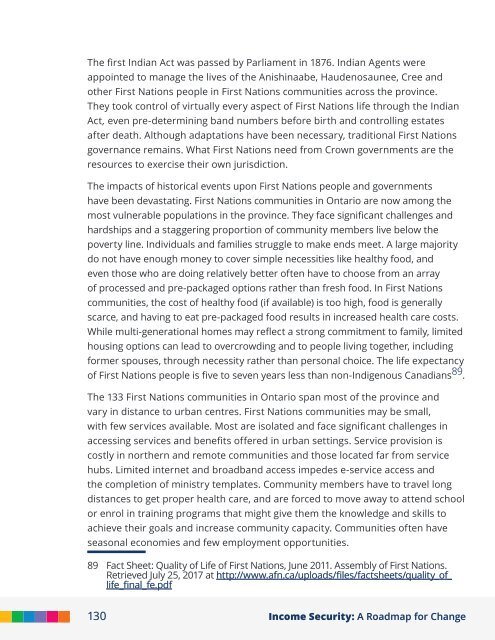Income Security: A Roadmap for Change
You also want an ePaper? Increase the reach of your titles
YUMPU automatically turns print PDFs into web optimized ePapers that Google loves.
The first Indian Act was passed by Parliament in 1876. Indian Agents were<br />
appointed to manage the lives of the Anishinaabe, Haudenosaunee, Cree and<br />
other First Nations people in First Nations communities across the province<br />
They took control of virtually every aspect of First Nations life through the Indian<br />
Act, even pre-determining band numbers be<strong>for</strong>e birth and controlling estates<br />
after death Although adaptations have been necessary, traditional First Nations<br />
governance remains What First Nations need from Crown governments are the<br />
resources to exercise their own jurisdiction<br />
The impacts of historical events upon First Nations people and governments<br />
have been devastating First Nations communities in Ontario are now among the<br />
most vulnerable populations in the province. They face significant challenges and<br />
hardships and a staggering proportion of community members live below the<br />
poverty line Individuals and families struggle to make ends meet A large majority<br />
do not have enough money to cover simple necessities like healthy food, and<br />
even those who are doing relatively better often have to choose from an array<br />
of processed and pre-packaged options rather than fresh food In First Nations<br />
communities, the cost of healthy food (if available) is too high, food is generally<br />
scarce, and having to eat pre-packaged food results in increased health care costs<br />
While multi-generational homes may reflect a strong commitment to family, limited<br />
housing options can lead to overcrowding and to people living together, including<br />
<strong>for</strong>mer spouses, through necessity rather than personal choice The life expectancy<br />
of First Nations people is five to seven years less than non-Indigenous Canadians 89 <br />
The 133 First Nations communities in Ontario span most of the province and<br />
vary in distance to urban centres First Nations communities may be small,<br />
with few services available. Most are isolated and face significant challenges in<br />
accessing services and benefits offered in urban settings. Service provision is<br />
costly in northern and remote communities and those located far from service<br />
hubs Limited internet and broadband access impedes e-service access and<br />
the completion of ministry templates Community members have to travel long<br />
distances to get proper health care, and are <strong>for</strong>ced to move away to attend school<br />
or enrol in training programs that might give them the knowledge and skills to<br />
achieve their goals and increase community capacity Communities often have<br />
seasonal economies and few employment opportunities<br />
89 Fact Sheet: Quality of Life of First Nations, June 2011 Assembly of First Nations<br />
Retrieved July 25, 2017 at http://www.afn.ca/uploads/files/factsheets/quality_of_<br />
life_final_fe.pdf<br />
130 <strong>Income</strong> <strong>Security</strong>: A <strong>Roadmap</strong> <strong>for</strong> <strong>Change</strong>
















